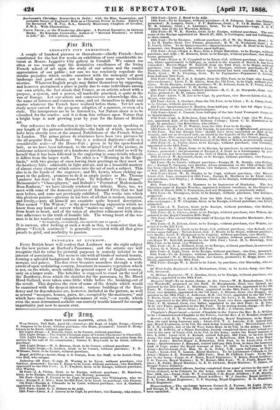Put Iris.
LEGGATT'S CITY EXHIBITION.
A couple of hundred pictures or thereabouts—chiefly French—have constituted for the last few weeks an exhibition of very considerable in- terest at Messrs. Leggatt's City gallery in Cornhill. We cannot too often or too warmly urge the distinctive excellences of the living French school of art upon the study of our artists and the candid appreciation of our public ; nor can we too resolutely repudiate the insular prejudice which credits ourselves with the monopoly of good landscape and good colour, not to dwell upon some more technical niceties. Whatever English people may flatter themselves by supposing, and however preeminent a place is justly due to some individuals among our own artists, the fact stands that France, as an artistic school with a purpose, a system, and a power, all markedly practical, is quite in the van of Europe. Let our artists and connoisseurs acknowledge this, in the name of fairness and common sense, and set themselves to study and master whatever the French have realized before them. Yet let such study never extend to the prepense adoption of a manner, or even of a style. The interpreters are to be listened to, but Nature alone is to be consulted for the oracles : and it is from this reliance upon Nature that a bright hope is now growing year by year for the future of British art.
Our reference to the collection is too late to warrant us in speaking at any length of the pictures individually—the bulk of which, moreover, have been already seen at the annual Rvhibitions of the French School in London. The prime pieces de resistance have been two pictures by the all-popular Rosa Bonhcur. One is a reduced duplicate—still on a considerable scale—of the Horse-Fair ; given in by the open-handed lady, as we have been informed, to the original buyer of the picture, in handsome acknowledgment of a handsome purchase, and rated so well by herself that it has been followed in the engraving in some details wherein it differs from the larger work. The other is a "Morning in the High- lands," with two groups of oxen lowing their greetings as they meet on the heathery hills : admirable in light and air, and in a beautiful mastery of almost every element which enters into the art of such a subject. This also is in the hands of the engraver; and Mr. Lewis, whose etching ap- pears in the gallery, promises to do it as ample justice as Mr. Thomas Landseer has done to the Horse-Fair. To Scheffer's "Ecce Homo," Meissonnier's " Chess-players," and Dubufe's " Portrait of Mademoiselle Rosa Bonheur," we have already rendered our tribute. Here, too, we meet with some of the domestic pictures of Edouard Frere that we had seen before, and some not previously exhibited. The works into which this glorious painter—glorious in his love of all that is modest, innocent, and lovely,—puts all himself are exquisite quite beyond description. That named "The Widow," is the most touching expression which we know from any hand of sorrow which "makes no sign," and yet speaks _from heart to heart, and of the union of absolute refinement with abso- lute adherence to the truth of humble life. The wrung heart of the wo- man is in her tearless and composed face " So tenderly, so tenderly, she needeth not to speak."
It is curious, after looking at such a work as this, to remember that the phrase " French sentiment " is generally associated with all that gives parade to grief, and morbidity to passion.


























 Previous page
Previous page